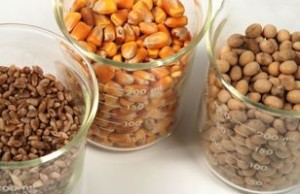 Grain futures edged higher on Tuesday amid speculation attractive low prices will boost demand. Wheat advanced for the first time after posting an 8-day declining period. Soybeans also gained.
Grain futures edged higher on Tuesday amid speculation attractive low prices will boost demand. Wheat advanced for the first time after posting an 8-day declining period. Soybeans also gained.
On the Chicago Mercantile Exchange, corn futures for September delivery traded at $5.3388 a bushel, up 0.43% on the day at 8:59 GMT. Prices ranged between daily high and low at $5.3425 and $5.2913 respectively. The grain declined throughout the last eight days, shedding 17.26% last week.
Corn rebounded today amid speculation that low prices may spur demand, while supplies in the U.S. declined before the next harvest. The grain has lost 28% so far this year and is the second worst performer after silver in the Standard & Poor’s GSCI gauge of 24 commodities. On Friday the USDA reported that 97.4 million acres of land was sown to corn, up from last year as a response to lowest stockpiles in June since 1997. This is the highest planted acreage in the U.S. since 1936. Growers expect to harvest 89.1 million acres for grain, up 2 percent from last year.
Graydon Chong, a grains and oilseed analyst at Rabobank International, said for Bloomberg: “Some of the market may see a little value here coming off the bottom. Whilst we are expecting larger crops this season, the market is still a little bit jittery ahead of the new supply coming online.”
U.S. corn output is expected to be 30% higher than last years crop and total 14.005 billion. Global production is also projected to be higher in the 2013-2014 season, standing at 946 million metric tons, compared to 854.5 million last year.
In its weekly crop progress report on Monday, the U.S. Department of Agriculture said that this years corn crop condition is a lot better than last years. As of June 30, only 8% of the crop was of “Very poor” and “Poor” quality, 25% was “Fair” and 67% had “Good” and “Excellent” qualities. Last year, 22% of the crop was categorized as “Very poor” and “Poor”, 30% was “Fair” and the remaining 48% fell in the “Good” and “Excellent” categories.
Wheat advances
Wheat also advanced for the first time in eight days, snapping its declining streak. The grain was pressured by the stronger dollar and ample global supply prospects. Wheat traded at $6.6125 a bushel at 9:01 GMT, marking a 0.95% daily gain. Prices held in range between days high and low of $6.6163 and $6.5588 respectively. Wheat fell for eight consecutive days and recorded a 5.87% weekly loss last week.
In its acreage report on Friday, the U.S. Department of Agriculture said that the planted area for 2013 will equal 56.5 million acres, 1% higher than last year. The 2013 winter wheat planted area equals 42.7 million acres, 3% above last year and up 2% from the previous estimate. Wheat prices fell nearly 3% on Friday after the USDA said wheat acreage was expected to hit the four-year high of 56.53 million. Increased wheat output is expected this year from Australia, Russia and Ukraine’s Black Sea region and Europe. Prices drew some support the past couple of weeks as rains delayed crop developing in the U.S.
In its crop progress report on Monday, the USDA said that as of June 30 43% of the winter wheat crop was planted, above the preceding weeks 20%. This was however below last years 73% during the comparable week and also below the five-year average 52%.
As for the spring wheat crop, the USDA reported that 93% has emerged as of June 30, compared to 90% during the prior week. This was below last years full emergence and the five-year average of 99%.
The government agency also said the spring wheat condition was overall matching last years. As of last week, 5% of the crop was categorized as “Very poor” and “Poor”, 27% was “Fair” and 68% was “Good” and “Excellent”. Meanwhile in 2012, 5% was of “Very poor” and “Poor” quality, 24% was “Fair” and 71% was “Good” and “Excellent”.
Soybeans gain as well
Elsewhere on the market, soybeans for August delivery also gained, standing at $14.4038 a bushel. The oilseed marked a 0.28% daily gain by 9:00 GMT, ranging between days high and low of $14.4063 and $14.3038 per bushel respectively. Soybeans swung between daily gains and losses during the past two weeks, but settled 4.17% lower last week. Soybeans were recently pressured by reduced demand outlook from the oilseed’s biggest consumer – China. The Asian country kept on piling negative economic data, including yesterday’s both PMI readings that generally matched projections, but were still lower than Mays figures. China also received another downward revision of its GDP growth forecast last week, this time by Goldman Sachs.
The USDA said in its report on Friday that the soybean planted area is estimated at a record high 77.7 million acres, up 1% compared to last year. Area for harvest, at 76.9 million acres, is up 1 percent from 2012 and will also be a record high, if realized.
In its weekly crop progress report on Monday, the USDA said that as of June 30 96% of the nations soybean crop was planted, compared to 92% during the preceding week. This however was lower than last years 100% and the five-year average of 98%.
The agency also said that 91% of the crop had emerged as of last week, compared to 81% during the prior one. This was lower than last years 99% during the comparable week and the five-year average of 94%.
As for the soybean crop condition, it is overall better than last season. As of June 30, 7% was categorized as “Very poor” and “Poor”, 26% was “Fair” and 67% was “Good” and “Excellent”. Last year, 22% of the crop fell in the “Very poor” and “Poor” categories, 33% in “Fair” and 45% was of “Good” and “Excellent” quality.





